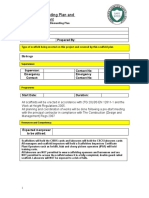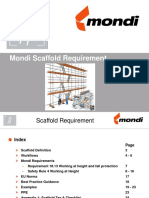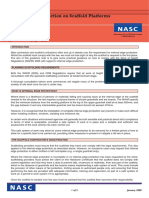Scaffold Work Handout
Scaffold Work Handout
Uploaded by
Rija HossainCopyright:
Available Formats
Scaffold Work Handout
Scaffold Work Handout
Uploaded by
Rija HossainOriginal Description:
Copyright
Available Formats
Share this document
Did you find this document useful?
Is this content inappropriate?
Copyright:
Available Formats
Scaffold Work Handout
Scaffold Work Handout
Uploaded by
Rija HossainCopyright:
Available Formats
ScaffoldWorkCanBeDangerous:KnowtheBasics
ofScaffoldSafety
There are thousands of scaffold-related injuries
and about 40 scaffold-related deaths every year in
the U.S. If you are doing work on scaffolds, know
how to work on them safely it could save your life!
Here are some rules about scaffolds that must be
followed if you want to work safely:
1. Acompetentpersonmust be available to direct
workers who are constructing or moving scaffolds. The competent person must also
train workers, andinspectthe scaffold and its componentsbeforeeverywork
shift,andafteranyeventthatcouldaffectthestructuralintegrityofthe
scaffold. The competent person must be able to identify unsafe conditions, and be
authorized by the employer to take action to correct unsafe conditions, to make the
workplace safe. And aqualifiedperson, someone who has very specific knowledge
or training, must actually design the scaffold and its rigging.
2. Everysupportedscaffold and its components mustsupport,withoutfailure,
itsownweightandatleastfourtimestheintendedload. The intended load is
the sum of the weights of all personnel, tools and materials that will be placed on
the scaffold. Dont load the scaffold with more weight than it can safely handle.
3. Onsupportedscaffolds, working platforms/decks must be planked close to the
guardrails. Planks are to be overlapped on a support at least 6 inches, but not more
than 12 inches.
4. Inspections ofsupportedscaffolds must include:
Checking metal components for bends, cracks, holes, rust, welding splatter,
pits, broken welds and non-compatible parts.
Covering and securing floor openings and labeling floor opening covers.
5. Each rope on asuspendedscaffold must support the scaffolds weight and at
leastsixtimesthe intended load.
6. Scaffoldplatformsmust be at least18incheswide,(therearesome
exceptions), and guardrails and/or personal fall arrest systems must be used for
fall protection any time you are working 10 feet or more above ground level.
Guardrailsmust be between 39 and 45 inches high, andmidrailsmust be installed
approximately halfway between the toprail and the platform surface.
7. OSHA standards require that workers havefallprotectionwhenworkingona
scaffold10ormorefeetabovetheground. OSHA requires the following:
The use of aguardrailORapersonalfallarrestsystemwhen working
on asupportedscaffold.
BOTHaguardrailANDapersonalfallarrestsystemwhen working on a
singlepointortwopointsuspendedscaffold.
Apersonalfallarrestsystemwhen working on anaeriallift.
8. Your lifeline must be tied back toastructuralanchoragecapable of
withstanding5,000lbsof dead weightperpersontied off to it. Attaching your
lifeline to a guardrail, a standpipe or other piping systems will not meet the 5,000
lbs requirement and is not a safe move.
9. Wear hard hats, and make sure there are toeboards, screens and debris nets in
placetoprotectotherpeoplefromfallingobjects.
10.Counterweightsforsuspendedscaffoldsmust be able to resist at leastfour
timesthetippingmoment, and they must be made of materials that cannot be
easily dislocated (no sand, no water, no rolls of roofing, etc.). [This would be
calculated by thequalifiedpersonwho designs the scaffold.]
11. Your employer must provide safe access to the scaffold when a platform is more
than two (2) feet above or below the point of access, or when you need to step
across more than 14 inches to get on the platform.Climbingoncrossbracesis
notallowed!Ladders, stair towers, ramps and walkways are some of the ways of
providing safe access.
12. All workers must betrainedon:
o how to use the scaffold, and how to recognize hazards associated with the
type of scaffold they are working on;
o the maximum intended load and capacity;
o how to recognize and report defects;
o fall hazards, falling object hazards and any other hazards that may be
encountered, including electrical hazards (such as overhead power lines);
and,
o having proper fall protection systems in place.
SOURCE:Construction Safety & Health Fall Hazards, Central New York COSH, 2007, OSHA grant
product
You might also like
- CO2 IIAR HandbookDocument188 pagesCO2 IIAR HandbookOnofreHalber100% (1)
- SG6 22 Management of Manual Handling in The Scaffolding IndustryDocument16 pagesSG6 22 Management of Manual Handling in The Scaffolding Industryscythe.shooterNo ratings yet
- White 1780 Sewing Machine Instruction ManualDocument57 pagesWhite 1780 Sewing Machine Instruction ManualiliiexpugnansNo ratings yet
- Fundamentals of Mechanical EngineeringDocument107 pagesFundamentals of Mechanical EngineeringPedro Sanchez83% (6)
- Suspended Scaffold Pre-Operation Inspection Checklist: Project InformationDocument4 pagesSuspended Scaffold Pre-Operation Inspection Checklist: Project InformationMartine OtienoNo ratings yet
- SG6 - 15 Manual Handling in The Scaffolding IndustryDocument48 pagesSG6 - 15 Manual Handling in The Scaffolding IndustryArdamit100% (1)
- Nasc SG26-22Document36 pagesNasc SG26-22Ardamit100% (1)
- Scaffold Training 2023Document98 pagesScaffold Training 2023HILAL ALSAMA100% (5)
- Birdcage Scaffold Plan & Method StatementDocument9 pagesBirdcage Scaffold Plan & Method StatementTeodoro EsquilloNo ratings yet
- SG28-17 Safe System of Work For Scaffolding Associated With Timber Frame Building ConstructionDocument24 pagesSG28-17 Safe System of Work For Scaffolding Associated With Timber Frame Building ConstructionMohammed HafizNo ratings yet
- Scaff TrainingDocument29 pagesScaff TrainingrakeshNo ratings yet
- Scaffolding Safety (Erecting and Dismantling)Document55 pagesScaffolding Safety (Erecting and Dismantling)Anonymous vpFlJMmKK50% (2)
- Working at Heights ManualDocument20 pagesWorking at Heights Manual1qazxcvbnmko098100% (2)
- Org - Gypsum.ga 216 07Document24 pagesOrg - Gypsum.ga 216 07anhnguyenhai100% (1)
- AURTTA004 Student Assessment Editable pdf2Document39 pagesAURTTA004 Student Assessment Editable pdf2ishworNo ratings yet
- Scaffolding Safety TrainingDocument25 pagesScaffolding Safety Trainingmt_powers100% (1)
- 28 - Scaffolding ProceduresDocument17 pages28 - Scaffolding ProceduresLalit Tomar100% (1)
- Access Birdcage ScaffoldsDocument22 pagesAccess Birdcage ScaffoldsJitendra Kumar AnandNo ratings yet
- CISRS Overseas 3 Day Scaffolding Supervisor PDFDocument1 pageCISRS Overseas 3 Day Scaffolding Supervisor PDFkrishna kumr100% (2)
- 11scaffolds Ladders Fall ProtectionDocument7 pages11scaffolds Ladders Fall ProtectionYoga Raja100% (1)
- SG29-17 Internal Edge Protection On Scaffold PlatformsDocument4 pagesSG29-17 Internal Edge Protection On Scaffold PlatformsMohammed HafizNo ratings yet
- Scaffold TrainingDocument34 pagesScaffold TraininggilNo ratings yet
- Duty of Care Act: Occupational Health and Safety Act 1984Document24 pagesDuty of Care Act: Occupational Health and Safety Act 1984Hoanghon BacNo ratings yet
- SG19 - A Guide To Formulating A Rescue PlanDocument8 pagesSG19 - A Guide To Formulating A Rescue PlanAnupam GhoshNo ratings yet
- Working at Height FINALDocument57 pagesWorking at Height FINALInnocent BhaikwaNo ratings yet
- 7 Scaffolding SafetyDocument15 pages7 Scaffolding SafetyMithlesh SinghNo ratings yet
- MR Scaffolding Limited: Harrods Method Statement Client-IconDocument9 pagesMR Scaffolding Limited: Harrods Method Statement Client-IconsudhakarjasNo ratings yet
- Scaffolding Safety (Erecting and Dismantling)Document55 pagesScaffolding Safety (Erecting and Dismantling)Tehman AlamNo ratings yet
- Cape Training Brochure - Asia Pacific Rim OffshoreDocument20 pagesCape Training Brochure - Asia Pacific Rim OffshoreSakuragi007No ratings yet
- a.WORKS AT HEIGHT RESCUEDocument11 pagesa.WORKS AT HEIGHT RESCUEcarl pelagioNo ratings yet
- NASC Safety Report 2012Document32 pagesNASC Safety Report 2012ArdamitNo ratings yet
- Scaffolding JSADocument10 pagesScaffolding JSAlabaimathuatqn2000No ratings yet
- Scaffold Specification Template PDFDocument20 pagesScaffold Specification Template PDFDiki FirmansahNo ratings yet
- Tower ScaffoldsDocument9 pagesTower Scaffoldshazopman100% (1)
- Scaffold Plan TOIPL PDFDocument11 pagesScaffold Plan TOIPL PDFDinesh Kanukollu100% (1)
- Scaffolding GuidanceDocument19 pagesScaffolding Guidanceabogadie100% (2)
- 12 Scaffold Inspectors CourseDocument155 pages12 Scaffold Inspectors CourseRobert EcleoNo ratings yet
- SG32 17 Provision of Extended and Telescopic Transoms and Board Brackets 1Document12 pagesSG32 17 Provision of Extended and Telescopic Transoms and Board Brackets 1Nizar MohamedNo ratings yet
- Cuplok Access Scaffold System-11Document24 pagesCuplok Access Scaffold System-11JijithpillaiNo ratings yet
- Tg20-Eguide CompressDocument28 pagesTg20-Eguide CompressMohd FirozNo ratings yet
- Scaffold ChecklistDocument2 pagesScaffold ChecklistHaleem Ur Rashid Bangash100% (1)
- CPCCLSF2001 Basic ScaffoldDocument66 pagesCPCCLSF2001 Basic ScaffoldArdamit100% (1)
- Scaffolding Awareness Rev 01 - 12 Mar 09Document22 pagesScaffolding Awareness Rev 01 - 12 Mar 09Raghavendra KiranNo ratings yet
- OSHA Scaffold Safety Requirements: A Scaffold Is A Temporary Structure Used in Construction and RepairDocument42 pagesOSHA Scaffold Safety Requirements: A Scaffold Is A Temporary Structure Used in Construction and RepairROMEL GONZAGA100% (1)
- Basic Scaffolding - QuestionsDocument9 pagesBasic Scaffolding - Questionsmohammed minhaj0% (1)
- Edge Protection Manual With ApprovalDocument12 pagesEdge Protection Manual With ApprovalClaudioKAD100% (1)
- 26.0 - Scaffolding v3.0 EnglishDocument26 pages26.0 - Scaffolding v3.0 Englishkaiserfaheem100% (2)
- Scaffold MondiDocument32 pagesScaffold MondisupriyantoNo ratings yet
- TG 20 Presentation 2014Document18 pagesTG 20 Presentation 2014obNo ratings yet
- Scaffolding Safety: Erection of Mobile ScaffoldingDocument18 pagesScaffolding Safety: Erection of Mobile Scaffoldingmuzica muzNo ratings yet
- Gen ScaffoldingsafetyDocument43 pagesGen ScaffoldingsafetyvhlactaotaoNo ratings yet
- TG20 12 - Supplement 1 - Revised 31 01.12Document16 pagesTG20 12 - Supplement 1 - Revised 31 01.12Hari HaranNo ratings yet
- SG29 - Internal Edge Protection On Scaffold PlatformsDocument2 pagesSG29 - Internal Edge Protection On Scaffold PlatformsAnupam GhoshNo ratings yet
- Scaffold Training 2018Document89 pagesScaffold Training 2018HILAL ALSAMANo ratings yet
- CISRS Scaffolding Supervisor - CITBDocument4 pagesCISRS Scaffolding Supervisor - CITBManda Khel Apna Des100% (1)
- Scaffold Ladder Safety 1569604009Document128 pagesScaffold Ladder Safety 1569604009eerrddeemmNo ratings yet
- Slide ScaffoldOverviewDocument32 pagesSlide ScaffoldOverviewVijayakumarVageesanNo ratings yet
- Know The Basics of Scaffold Safety: Disusun Oleh: Tri Okta Kharisma F. Febriarno WiranomoDocument10 pagesKnow The Basics of Scaffold Safety: Disusun Oleh: Tri Okta Kharisma F. Febriarno WiranomoFebri ArnoNo ratings yet
- SOPDocument8 pagesSOPAilyn MercadoNo ratings yet
- Chapter 3: Fall Protection/ Scaffolding Safety: Learning ObjectivesDocument18 pagesChapter 3: Fall Protection/ Scaffolding Safety: Learning ObjectivessrdrNo ratings yet
- Scaffolding SafetyDocument2 pagesScaffolding SafetyJaymar O. BuenaventeNo ratings yet
- SOP For ScaffoldingDocument5 pagesSOP For ScaffoldingkannanNo ratings yet
- Cuplock Scuffolding SOPDocument3 pagesCuplock Scuffolding SOPElangoNo ratings yet
- Appendix-B - Construction Safey Manual at ProjectsDocument112 pagesAppendix-B - Construction Safey Manual at ProjectsvinodNo ratings yet
- Engineering Economics: Fundamentals of Engineering Exam ReviewDocument4 pagesEngineering Economics: Fundamentals of Engineering Exam ReviewRija HossainNo ratings yet
- Chemical and Liquid Resistant Gloves PDFDocument6 pagesChemical and Liquid Resistant Gloves PDFRija HossainNo ratings yet
- Appendix C - Fatal Fact 30Document1 pageAppendix C - Fatal Fact 30Rija HossainNo ratings yet
- Appendix C - Fatal Fact 28Document1 pageAppendix C - Fatal Fact 28Rija HossainNo ratings yet
- Appendix C - Fatal Fact 17Document1 pageAppendix C - Fatal Fact 17Rija HossainNo ratings yet
- Appendix C - Fatal Fact 11Document1 pageAppendix C - Fatal Fact 11Rija HossainNo ratings yet
- Glass - Craft - FinalDocument65 pagesGlass - Craft - FinalPayallulla7No ratings yet
- Airbus A320 Inst Power PlantDocument42 pagesAirbus A320 Inst Power PlantPanagiotis Diakidis100% (1)
- Stainless SteelDocument51 pagesStainless Steelcristian111111No ratings yet
- Group 1 - ManuscriptDocument39 pagesGroup 1 - ManuscriptKathleen Kaye CastilloNo ratings yet
- MetraWireHarness 120706502Document2 pagesMetraWireHarness 120706502Tanner WitherspoonNo ratings yet
- Aluminium Dross Hot and Cold Recovery MethodDocument15 pagesAluminium Dross Hot and Cold Recovery MethodJerry PraweenNo ratings yet
- R7D B Manual en 201202Document327 pagesR7D B Manual en 201202CarlosAFFurtadoNo ratings yet
- WI 190 004 Cosmetics Acceptability Rev A PDFDocument18 pagesWI 190 004 Cosmetics Acceptability Rev A PDFUlysses CarrascoNo ratings yet
- GT Class TKGTPSDocument84 pagesGT Class TKGTPSGnanaseharan Arunachalam100% (1)
- RC Datasheet PDFDocument20 pagesRC Datasheet PDFRicardo BarrosNo ratings yet
- Lecture 3 Titanium and Its AlloysDocument13 pagesLecture 3 Titanium and Its AlloysEric TaylorNo ratings yet
- Concrete Design - Comparison is-BSDocument10 pagesConcrete Design - Comparison is-BSStephen Rajkumar JayakumarNo ratings yet
- Midea InverterDocument47 pagesMidea Invertertomasdeleon100% (1)
- Continuous Production SystemDocument7 pagesContinuous Production SystemPooja NagNo ratings yet
- PDFM 4.0 BrochureDocument4 pagesPDFM 4.0 BrochureRubén Muñoz TorresNo ratings yet
- HILTI Technology ManualDocument210 pagesHILTI Technology ManualRoger Yan100% (1)
- MSDS - Degacryl - HS - 4296 - eDocument2 pagesMSDS - Degacryl - HS - 4296 - ePiero CaballeroNo ratings yet
- ET Manufacturing SummitDocument6 pagesET Manufacturing SummitFrank HayesNo ratings yet
- Designing Clean Room HVAC SystemsDocument10 pagesDesigning Clean Room HVAC Systemssushant_jhawer100% (1)
- Experience Fouling Factor ValuesDocument3 pagesExperience Fouling Factor ValuesAwais AhmedNo ratings yet
- Mason Industries, Inc.: Position 1 (Floor in Poured Position) Position 2 (Spring & Neoprene Cup Installed)Document1 pageMason Industries, Inc.: Position 1 (Floor in Poured Position) Position 2 (Spring & Neoprene Cup Installed)Mai Tuan AnhNo ratings yet
- WSI 25 1 10X38 1KV enDocument6 pagesWSI 25 1 10X38 1KV enLautriv Sports HouseNo ratings yet
- Individual Ass Magagula Business PlanDocument17 pagesIndividual Ass Magagula Business PlanElvisNo ratings yet
- HeuristicsDocument13 pagesHeuristicsraja.mtNo ratings yet
- Melfa Industrial RobotDocument56 pagesMelfa Industrial RobotSanja KovačićNo ratings yet































































































